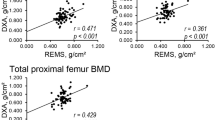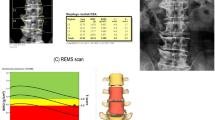Abstract
Summary
An innovative, non-ionizing technique to diagnose osteoporosis on lumbar spine and femoral neck was evaluated through a multicenter study involving 1914 women. The proposed method showed significant agreement with reference gold standard method and, therefore, a potential for early osteoporosis diagnoses and possibly improved patient management.
Introduction
To assess precision (i.e., short term intra-operator precision) and diagnostic accuracy of an innovative non-ionizing technique, REMS (Radiofrequency Echographic Multi Spectrometry), in comparison with the clinical gold standard reference DXA (dual X-ray absorptiometry), through an observational multicenter clinical study.
Methods
In a multicenter cross-sectional observational study, a total of 1914 postmenopausal women (51–70 years) underwent spinal (n = 1553) and/or femoral (n = 1637) DXA, according to their medical prescription, and echographic scan of the same anatomical sites performed with the REMS approach. All the medical reports (DXA and REMS) were carefully checked to identify possible errors that could have caused inaccurate measurements: erroneous REMS reports were excluded, whereas erroneous DXA reports were re-analyzed where possible and otherwise excluded before assessing REMS accuracy. REMS precision was independently assessed.
Results
In the spinal group, quality assessment on medical reports produced the exclusion of 280 patients because of REMS errors and 78 patients because of DXA errors, whereas 296 DXA reports were re-analyzed and corrected. Analogously, in the femoral group there were 205 exclusions for REMS errors, 59 exclusions for DXA errors, and 217 re-analyzed DXA reports. In the resulting dataset (n = 1195 for spine, n = 1373 for femur) REMS outcome showed a good agreement with DXA: the average difference in bone mineral density (BMD, bias ± 2SD) was −0.004 ± 0.088 g/cm2 for spine and − 0.006 ± 0.076 g/cm2 for femur. Linear regression showed also that the two methods were well correlated: standard error of the estimate (SEE) was 5.3% for spine and 5.8% for femur. REMS precision, expressed as RMS-CV, was 0.38% for spine and 0.32% for femur.
Conclusions
The REMS approach can be used for non-ionizing osteoporosis diagnosis directly on lumbar spine and femoral neck with a good level of accuracy and precision. However, a more rigorous operator training is needed to limit the erroneous acquisitions and to ensure the full clinical practicability.





Similar content being viewed by others
References
Kanis JA (2007) WHO Technical Report. University of Sheffield, UK, p 66
Johnell O, Kanis JA (2006) An estimate of the worldwide prevalence and disability associated with osteoporotic fractures. Osteoporos Int 17:1726–1733
Cosman F, de Beur SJ, LeBoff MS, Lewiecki EM, Tanner B, Randall S, Lindsay R (2014) Clinician’s guide to prevention and treatment of osteoporosis. Osteoporos Int 25:2359–2381
Lewiecki EM, Laster AJ (2006) Clinical review: clinical applications of vertebral fracture assessment by dual-energy X-ray absorptiometry. J Clin Endocrinol Metab 91(11):4215–4222
Abrahamsen B, van Staa T, Ariely R, Olson M, Cooper C (2009) Excess mortality following hip fracture: a systematic epidemiological review. Osteoporos Int 20(10):1633–1650
Office of the Surgeon General (US) (2004) Bone health and osteoporosis: a report of the Surgeon General. Office of the Surgeon General (US), Rockville (MD). Available from: http://www.ncbi.nlm.nih.gov/books/NBK45513/. Accessed December 2017
Cosman F, de Beur SJ, LeBoff MS, Lewiecki EM, Tanner B, Randall S, Lindsay R (2015) Erratum to: clinician’s guide to prevention and treatment of osteoporosis. Osteoporos Int 26:2045–2047
International Osteoporosis Foundation (2000) How fragile is her future? Survey and Report. Available from:https://www.iofbonehealth.org/how-fragile-her-future. Accessed 12 June 2000
International Osteoporosis Foundation (2001) Osteoporosis in the European community: a call to action. Avalible from: https://www.iofbonehealth.org/osteoporosis-european-community-call-action. Accessed 18 December 2001
Quiros Roldan E, Brianese N, Raffetti E, Focà E, Pezzoli MC, Bonito A, Ferraresi A, Lanza P, Porcelli T, Castelli F (2017) Comparison between the gold standard DXA with calcaneal quantitative ultrasound based-strategy (QUS) to detect osteoporosis in an HIV infected cohort. Braz J Infect Dis 21:581–586
Schnitzer TJ, Wysocki N, Barkema D, Griffith J, Lent V, Romba M, Welbel R, Bhuva S, Manyam B, Linn S (2012) Calcaneal quantitative ultrasound compared with hip and femoral neck dual-energy X-ray absorptiometry in people with a spinal cord injury. PM R 4:748–755
Shin M-H, Kweon S-S, Park K-S, Heo H, Kim S-J, Nam H-S, Jeong S-K, Chung E-K, Choi J-S (2005) Quantitative ultrasound of the calcaneus in a Korean population: reference data and relationship to bone mineral density determined by peripheral dual X-ray absorptiometry. J Korean Med Sci 20:1011–1016
Paggiosi MA, Barkmann R, Gluer CC, Roux C, Reid DM, Felsenberg D, Bradburn M, Eastell R (2012) A European multicenter comparison of quantitative ultrasound measurement variables: the OPUS study. Osteoporos Int 23:2815–2828
Kwok T, Khoo CC, Leung J, Kwok A, Qin L, Woo J, Leung PC (2012) Predictive values of calcaneal quantitative ultrasound and dual energy X-ray absorptiometry for non-vertebral fracture in older men: results from the MrOS study (Hong Kong). Osteoporos Int 23:1001–1006
Liu JM, Ma LY, Bi YF, Xu Y, Huang Y, Xu M, Zhao HY, Sun LH, Tao B, Li XY, Wang WQ, Ning G (2012) A population-based study examining calcaneus quantitative ultrasound and its optimal cut-points to discriminate osteoporotic fractures among 9352 Chinese women and men. J Clin Endorinol Metab 97:800–809
Moayyeri A, Adams JE, Adler RA, Krieg MA, Hans D, Compston J, Lewiecki EM (2012) Quantitative ultrasound of the heel and fracture risk assessment: an updated meta-analysis. Osteoporos Int 23:143–153
Jiang YQ, Liu CC, Li RY, Wang WP, Ding H, Qi Q, Ta D, Dong J, Wang WQ (2014) Analysis of apparent integrated backscatter coefficient and backscatter spectral centroid shift in calcaneus in vivo for the ultrasonic evaluation of osteoporosis. Ultrasound Med Biol 40:1307–1317
Garra BS, Locher M, Felker S, Wear KA (2009) Measurements of ultrasonic backscattered spectral centroid shift from spine in vivo: methodology and preliminary results. Ultrasound Med Biol 35:165–168
Karjalainen JP, Riekkinen O, Toyras J, Hakulinen M, Kroger H, Rikkonen T, Salovaara K, Jurvelin JS (2012) Multi-site bone ultrasound measurements in elderly women with and without previous hip fractures. Osteoporos Int 23:1287–1295
Barkmann R, Dencks S, Laugier P, Padilla F, Brixen K, Ryg J, Seekamp A, Mahlke L, Bremer A, Heller M, Gluer CC (2010) Femur ultrasound (FemUS)—first clinical results on hip fracture discrimination and estimation of femoral BMD. Osteoporos Int 21:969–976
Schousboe JT, Riekkinen O, Karjalainen J (2017) Prediction of hip osteoporosis by DXA using a novel pulse-echo ultrasound device. Osteoporos Int 28:85–93
Karjalainen JP, Riekkinen O, Töyräs J, Jurvelin JS, Kröger H (2016) New method for point-of-care osteoporosis screening and diagnostics. Osteoporos Int 27:971–977
McCloskey EV, Kanis JA, Odén A, Harvey NC, Bauer D, González-Macias J, Hans D, Kaptoge S, Krieg MA, Kwok T, Marin F, Moayyeri A, Orwoll E, Gluёr C, Johansson H (2015) Predictive ability of heel quantitative ultrasound for incident fractures: an individual-level meta-analysis. Osteoporos Int 26:1979–1987
Chan MY, Nguyen ND, Center JR, Eisman JA, Nguyen TV (2013) Quantitative ultrasound and fracture risk prediction in non-osteoporotic men and women as defined by WHO criteria. Osteoporos Int 24:1015–1022
Conversano F, Franchini R, Greco A, Soloperto G, Chiriacò F, Casciaro E, Aventaggiato M, Renna MD, Pisani P, Di Paola M, Grimaldi A, Quarta L, Quarta E, Muratore M, Laugier P, Casciaro S (2015) A novel ultrasound methodology for estimating spine mineral density. Ultrasound Med Biol 41:281–300
Casciaro S, Peccarisi M, Pisani P, Franchini R, Greco A, De Marco T, Grimaldi A, Quarta L, Quarta E, Muratore M, Conversano F (2016) An advanced quantitative echosound methodology for femoral neck densitometry. Ultrasound Med Biol 42:1337–1356
Casciaro S, Conversano F, Pisani P, Muratore M (2015) New perspectives in echographic diagnosis of osteoporosis on hip and spine. Clin Cases Miner Bone Metab 12:143–151
Messina C, Bandirali M, Sconfienza LM, D’Alonzo NK, Di Leo G, Papini GDE, Ulivieri FM, Sardanelli F (2015) Prevalence and type of errors in dual-energy x-ray absorptiometry. Eur Radiol 25:1504–1511
Engelke K, Gluer CC (2006) Quality and performance measures in bone densitometry. Part 1: errors and diagnosis. Osteoporos Int 17:1283–1292
Shepherd JA, Schousboe JT, Broy SB, Engelke K, Leslie WD (2015) Executive summary of the 2015 ISCD position development conference on advanced measures from DXA and QCT: fracture prediction beyond BMD. J Clin Densitom 18:274–286
Altman DG, Bland JM (1983) Measurements in medicine: the analysis of method comparison studies. Statistician 32:307–317
Hui SL, Gao S, Zhou X-H, Johnston CC Jr, Lu Y, Glüer CC, Grampp S, Genant H (1997) Universal standardization of bone density measurements: a method with optimal properties for calibration among several instruments. J Bone Miner Res 12:1463–1470
Lu Y, Fuerst T, Hui S, Genant HK (2001) Standardization of bone mineral density at femoral neck, trochanter and Ward’s triangle. Osteoporos Int 12:438–444
Hans DB, Shepherd JA, Schwartz EN, Reid DM, Blake GM, Fordham JN, Fuerst T, Hadji P, Itabashi A, Krieg MA, Lewiecki EM (2008) Peripheral dual-energy x-ray absorptiometry in the management of osteoporosis: the 2007 ISCD official positions. J Clin Densitom 11:188–206
Blake GM, Chinn DJ, Steel SA, Patel R, Panayiotou E, Thorpe J, Fordham JN, National Osteoporosis Society Bone Densitometry (2005) A list of device-specific thresholds for the clinical interpretation of peripheral x-ray absorptiometry examinations. Osteoporos Int 16:2149–2156
Hopkins SJ, Welsman JR, Knapp KM (2014) Short-term precision error in dual energy x-ray absorptiometry, bone mineral density and trabecular bone score measurements; and effects of obesity on precision error. Journal of Biomedical Graphics and Computing 4:8–14
Ravaud P, Reny JL, Giraudeau B, Porcher R, Dougados M, Roux C (1999) Individual smallest detectable difference in bone mineral density measurements. J Bone Miner Res 14:1449–1456
Trevisan C, Gandolini GG, Sibilla P, Penotti M, Caraceni MP, Ortolani S (1992) Bone mass measurement by DXA: influence of analysis procedures and interunit variation. J Bone Miner Res 7:1373–1382
Larnach TA, Boyd SJ, Smart RC, Butler SP, Rohl PG, Diamond TH (1992) Reproducibility of lateral spine scans using dual energy X-ray absorptiometry. Calcif Tissue Int 51:255–258
Raffan E, Holden SL, Cullingham F, Hackett RM, Rawlings JM, German AJ (2006) Standardized positioning is essential for precise determination of body composition using dual-energy X-ray absorptiometry in dogs. J Nutr 136:1976S–1978S
Acknowledgments
The authors thank Carla Signorini for her help and assistance in performing the DXA scans.
Funding
This work was partially funded by the National Research Council, Institute of Clinical Physiology, Lecce (Italy) within the project “Non-ionizing diagnoses in rheumatology—ECO MOC.”
Author information
Authors and Affiliations
Corresponding author
Ethics declarations
Conflicts of interest
Marco Di Paola, Davide Gatti, Ombretta Viapiana, Luisella Cianferotti, Loredana Cavalli, Carla Caffarelli, Eugenio Quarta, Paola Pisani, Giuseppe Girasole, Andrea Giusti, Monica Manfredini, Giovanni Arioli, Marco Matucci Cerinic, Gerolamo Bianchi, Ranuccio Nuti, Stefano Gonnelli, Maria Luisa Brandi, Maurizio Muratore, and Maurizio Rossini have no conflicts of interests.
Francesco Conversano owns stocks of Echolight Spa.
Rights and permissions
About this article
Cite this article
Di Paola, M., Gatti, D., Viapiana, O. et al. Radiofrequency echographic multispectrometry compared with dual X-ray absorptiometry for osteoporosis diagnosis on lumbar spine and femoral neck. Osteoporos Int 30, 391–402 (2019). https://doi.org/10.1007/s00198-018-4686-3
Received:
Accepted:
Published:
Issue Date:
DOI: https://doi.org/10.1007/s00198-018-4686-3




